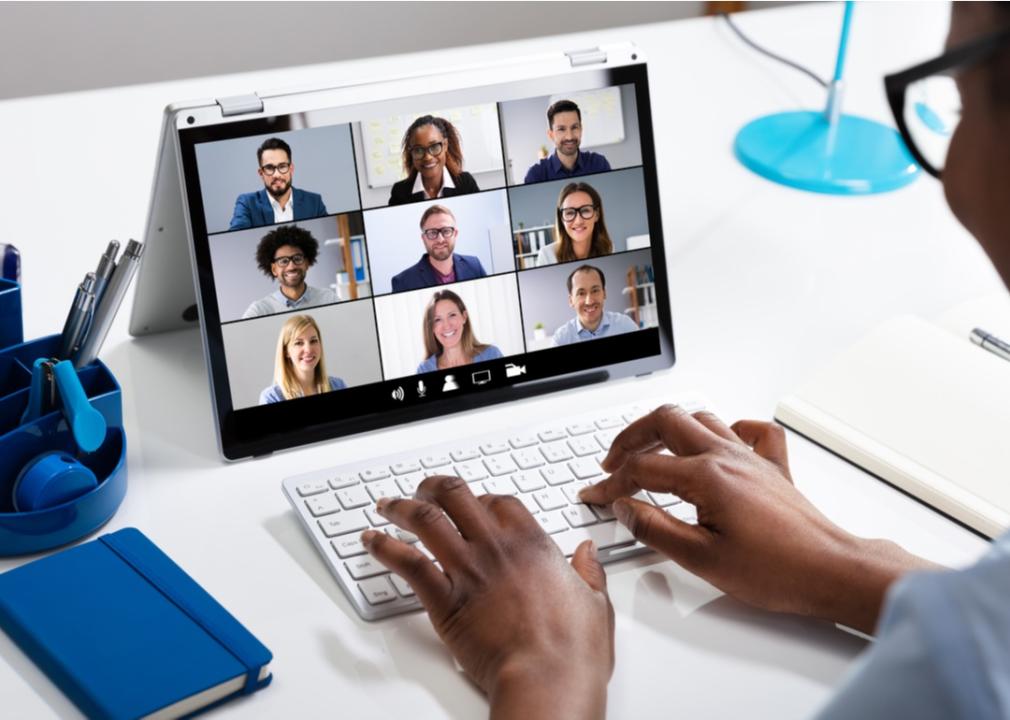10 ways companies are building connections in remote workplaces
Andrey_Popov // Shutterstock
10 ways companies are building connections in remote workplaces
Remote work is here to stay—whether bosses like it or not. Forty-five percent of full-time U.S. employees work from home, with 25% always working from home and 20% working from home at least part of the time, according to Gallup polling data from September 2021.
Kazoo compiled information about how companies are working to strengthen office culture and interpersonal connections in virtual workplaces since the rise of remote work during the pandemic. The information comes from a diverse range of sources including experts, surveys, and news reports.
While some employees prefer working in the office, others—including the majority of parents and Black workers—prefer working from the comfort of their own homes. A 2021 Remote Work Report found that if remote work was suddenly no longer an option, a third of respondents would leave their job—either by finding a new role or retiring.
While many remote workers tout the benefits of no commute, more flexibility for family and personal time, and the convenience of doing a load of laundry during the day, building meaningful connections with colleagues is far more difficult when you don’t share the same physical space. There are digital alternatives that leaders across industries are experimenting with to inspire culture-building and collaboration, from coffee breaks to happy hours. Some virtual experiments have worked well, and some just can’t hold a candle to in-person interactions.
![]()
Dexiao Productions // Shutterstock
Virtual coffee breaks
Virtual coffee breaks are a way to refresh the brain during a long meeting or at a virtual conference to break things up. These breaks also allow people to engage in less work-centric conversations or brainstorming sessions. While hot drinks are optional, these 15- to 30-minute informal conversations have been implemented by a third of companies surveyed by GitLab as a way to foster community during hybrid or remote work.
Using video conferencing software, participants might engage in a one-on-one, getting-to-know-you chat, or they might be themed around an organized activity such as trivia, a chair workout, or a meditation session. Virtual coffee chats seek to replace the informal break room banter and help colleagues get to know each other better in a more relaxed setting. They can also be used to increase energy and allow people to decompress between meetings the way they might if they were physically running into coworkers in the office.
LightField Studios // Shutterstock
Remote lunch-and-learns
Remote lunch-and-learns are a great way to refresh knowledge and skills while showcasing an individual’s expertise. At each regularly scheduled lunch-and-learn, a different team member prepares a presentation to teach their colleagues a new skill, dive deep into a challenge they faced and how they solved it, or introduce a new concept or way of working. Lunch-and-learns are a good way to hand the floor to a colleague who doesn’t usually run meetings but has something valuable to share.
While it was easy to cater for in-person lunch-and-learns, the nature of remote work makes the food portion of the event a bit trickier to handle. Some companies reimburse attendees and others use services like GrubHub to deliver food.
fizkes // Shutterstock
Fostering informal interactions
Informal interactions help colleagues build trust and bond as a team: In-person workers run into each other and often share ideas and problems naturally and spontaneously. In a virtual work environment, it’s counterintuitive but important to schedule unstructured time into meeting agendas.
Setting aside the last 10 minutes of a meeting for attendees to talk about whatever’s on their mind in whole-group or break-out sessions is one way to share ideas. Scheduling office hours or an open-door policy where leaders invite their reports to make video calls the norm among the team can also help keep teams collaborating rather than working in silos.
Tryzkropy // Shutterstock
Virtual game nights
Game nights took off during the pandemic with companies like Kahoot, JackBox, and Heads Up! upping their virtual offerings. While an after-hours Zoom trivia session with friends can be energizing, forced after-work socializing is not a perk: Many workers feel forced into attending.
If a work virtual game night is scheduled, it should be truly voluntary where team members don’t feel social pressure to join if they need a break from their screens. Alternatives include embedding brain breaks and trivia questions into meetings. Building connections with colleagues should happen on the clock; sometimes the best way to build connections is to give employees their time back so they’re refreshed for the next day.
fizkes // Shutterstock
Enabling ‘toxic culture alarms’
It’s not uncommon for empathetic and highly sensitive people to be told to toughen up in the workplace. Sensitive people can often predict toxic culture, impossibly high workloads, and bad management decisions before many of their colleagues.
By empowering (rather than silencing) employees who report sexism, racism, or other issues at the workplace, managers can appropriately deal with issues before they become endemic in the organization. A toxic culture “alarm” does not need to be an abrupt alarm at all: Providing an outlet for office culture feedback can help to mitigate workplace inequity.
Paying extra attention to the needs of the most vulnerable colleagues—including employees of color, working mothers, and those with disabilities—makes the workplace more welcoming for everyone. “Designing for the margin” means focusing on those who are most likely to face obstacles at work and making sure policies are written to help them succeed.
Prostock-studio // Shutterstock
Leadership transparency
Employees are generally happier and stay with a company longer when they trust leadership and feel that decision-making is transparent. The Remote Work Report from GitLab found 34% of respondents reported leadership transparency leads to connectedness in the workplace. Similarly, 38% said that increased visibility into an organization improved feelings of connection.
Understanding how all the moving pieces fit together helps people grasp the impact of their work on the company and even the greater public. Providing staff with regular updates from each department along with any new company-wide developments can seriously improve leadership transparency.
Nattakorn_Maneerat // Shutterstock
Digital lobbies
Digital lobbies are social gathering places for people to virtually network, build connections, and hear announcements from leaders. Functioning as virtual meeting places where company culture is felt and practiced, some digital lobby platforms help remote workforces align and connect; others allow for workflow or status updates, or can integrate with Slack to promote water-cooler talk.
Workers who feel like they really know their colleagues are more likely to stay at a job and report that their work feels less transactional. Virtual lobbies can be like a social network for coworkers who can pop in to ask questions, congratulate one another, and post announcements.
REDPIXEL.PL // Shutterstock
Cross-team collaborative projects
Cross-team projects shake up people’s usual ways of working and get them out of their comfort zones. When working with a new group, collaborators need to learn each members’ working style and communication style. New ideas are often born when people from different backgrounds or areas of expertise brainstorm together.
Successful cross-team collaborations require well-communicated group goals and milestones to keep everyone on track and on budget. Since remote work can encourage social loafing, it’s important for each team member to have individual metrics as well as team goals.
LightField Studios // Shutterstock
Creating a sense of ‘regenerative’ work
Regenerative workplaces seek to give back to employees more than they extract. Think in addition to competitive salaries also folding in individualized perks that capitalize on community. The values of employees who may not stay long-term can have a big impact if they feel connected to the company during their tenure.
Some examples of embracing a regenerative workplace include generous time-off policies so workers can comfortably find a work-life balance, childcare perks, and decision-making and collaborative thinking across every level of the company. Overall, regenerative workplaces think long-term and do not see their workers as expendable. Instead of compartmentalizing roles, a regenerative workplace ties everyone’s contributions to the overall business strategy and goals. Employees know exactly how they contribute to solving clients’ problems and strive to create a better working society.
fizkes // Shutterstock
Quarterly or biannual in-person summits
Some companies have transitioned to be fully remote while others operate on a hybrid model. While there are plenty of tools for collaborating with colleagues virtually, nothing truly replaces the synergy of physically being present together.
Quarterly or semi-annual in-person summits can build community and help people connect. From one-day meetings to week-long retreats, companies are recognizing the importance of facetime. Some in-person summits focus on fun and team building, while others focus on strategic planning and big-picture thinking.
This story originally appeared on Kazoo
and was produced and distributed in partnership with Stacker Studio.











